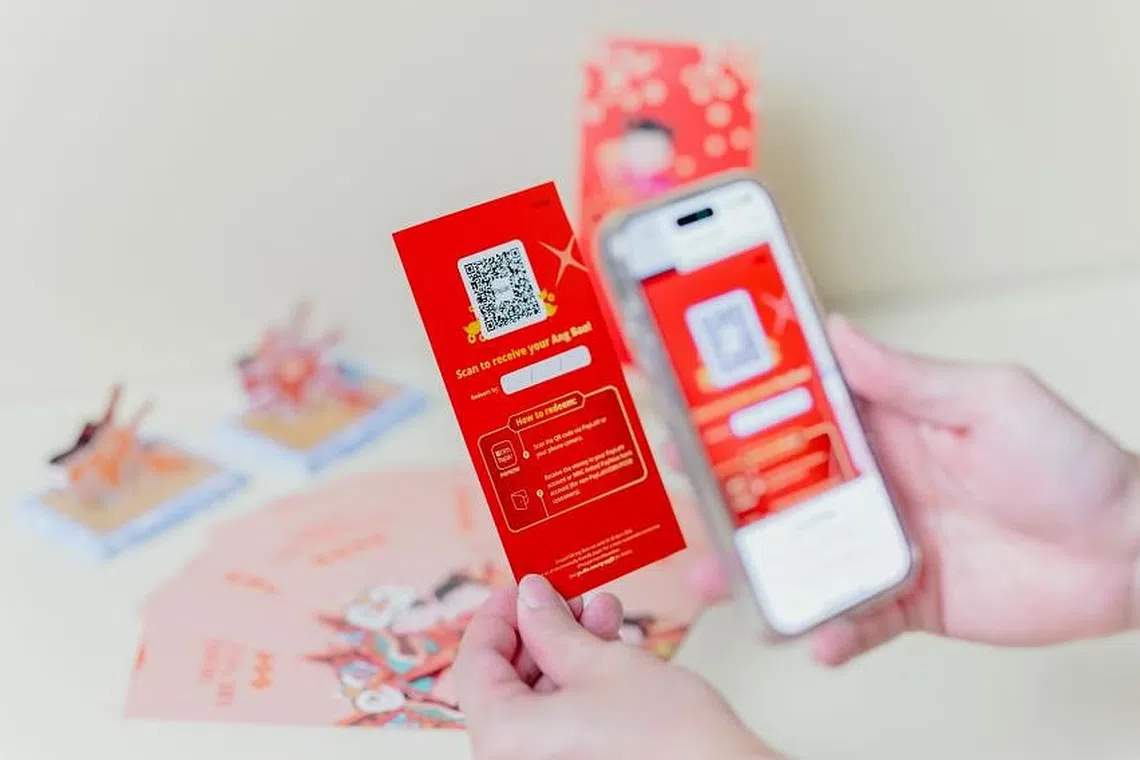More e-hongbao given out in Singapore this Chinese New Year
Sign up now: Get ST's newsletters delivered to your inbox

DBS QR gift cards are physical gift cards that replace traditional red packets, which allow users to scan a QR code to load cash.
PHOTO: DBS BANK
Follow topic:
SINGAPORE – Digital red packets, or e-hongbao, have become increasingly popular during Chinese New Year here, with banks seeing more of such electronic transfers during the festive season in 2024 compared with 2023.
The latest figures from most banks and multi-currency card providers The Straits Times contacted showed increases in the number of transactions and the amount of money transacted.
DBS Bank said more than $17.5 million was transferred via its QR Ang Bao and eGift from Feb 9 to 12, representing a 30 per cent increase year on year.
It also saw the number of customers using these e-gifting means from Jan 15 to Feb 12 double compared with the same period in 2023.
A QR Ang Bao is a physical card with a QR code, which recipients scan to redeem a preloaded amount, while the bank’s customers can also use the eGift function on its PayLah! app to transfer money digitally.
OCBC Bank said the number of e-hongbao sent in the first three days of Chinese New Year increased by 2.5 times compared with 2023, with the bank projecting the total number sent over the 15-day festive period to be three times more than that in 2023.
UOB said the total amount of money sent via digital red packets from Feb 9 to 15 jumped by about 60 per cent year on year, while the number of PayNow transactions and number of customers sending e-hongbao increased by a third.
DBS was the first to offer an e-hongbao service in Singapore in 2015, and digital red packets have become popular in the last few years amid a push for sustainability as well as social distancing restrictions put in place during the Covid-19 pandemic.
Dr Kapil Tuli, professor of marketing at Singapore Management University, said more people started using e-hongbao during the pandemic as they saw it as a safer way of gifting than physical red packets.
They are also convenient, environment-friendly and reduce the problem of giving physical packets with the wrong denomination, he added.
Homemaker Joan Lim, 31, said she started giving e-hongbao in 2022 as it was more convenient.
“E-hongbao save me the hassle of having to find and count cash, as well as putting the notes into the red packets.”
They also reduce the need to print new notes, she added.
In January, the Monetary Authority of Singapore said more than 11 million pieces of fit notes were exchanged
The carbon footprint of producing that number of new notes would be comparable with the emissions from powering about 220 four-room Housing Board flats annually.
Experts ST spoke to are expecting the use of e-hongbao to continue to rise as digital payments become more convenient and accessible.
Ms Wong Wanyi, fintech leader at PwC Singapore, said the increased use of e-hongbao is consistent with the growing use of mobile payments as consumers get more accustomed to online payments and reduce their reliance on cash.
“While pandemic restrictions have eased, behaviour has permanently changed because the users have now experienced the ease and speed of digital payments,” she said.
Some banks have also noted a rise in the use of e-hongbao among their younger and older customers.
Traditionally, younger people tend to receive, not give, red packets, while older folk are seen as being slower to pick up new technologies.
DBS said that in 2023, there was a 25 per cent increase in the number of e-hongbao sent by those aged 62 and above, compared with 2022.
Over at OCBC, those aged 16 to 22 made up 25 per cent of those sending e-hongbao in 2024, up from 16 per cent in 2023.
“They do not fit the profile of traditional hongbao givers, who are usually married and above the age of 30,” said Ms Ng Lee Peng, OCBC’s head of digital business in Singapore.
“They could be paying their friends back, but chose to send the money in e-hongbao format, writing auspicious messages and choosing one of our e-hongbao designs.”
Banks and multi-currency card providers are also using features – such as customised e-hongbao skins and participation in lucky draws – to get more people to use the feature.
OCBC customers will be prompted on the bank’s app to open an e-hongbao, which could be accompanied by a personalised greeting, while UOB allows its customers to choose from several e-hongbao skins depicting the Year of the Dragon.
YouTrip, a multi-currency card provider, introduced a dragon-themed digital hunt on its app in 2024, where users try to hunt for “rare dragons” – containing cash prizes of up to $8,888 – by sending and receiving as many e-hongbao as possible.
Despite their increasing popularity, Dr Lee Yen Teik, a senior lecturer at the National University of Singapore Business School, said e-hongbao are unlikely to fully replace traditional red packets due to their significant cultural value and personal touch.
He expects both e-hongbao and physical packets to continue being used for the festive season.
One hongbao giver, Mr Andre Lim, prefers to mix tradition with technology through the use of red packets containing gift cards with QR codes.
“If the money is only sent via the app, the act of giving a red packet loses its joy and personal touch,” said the 37-year-old digital transformation director.
“But if you are giving a red packet with the QR code gift card, it is as good as receiving a red packet with cash for the recipients.”


